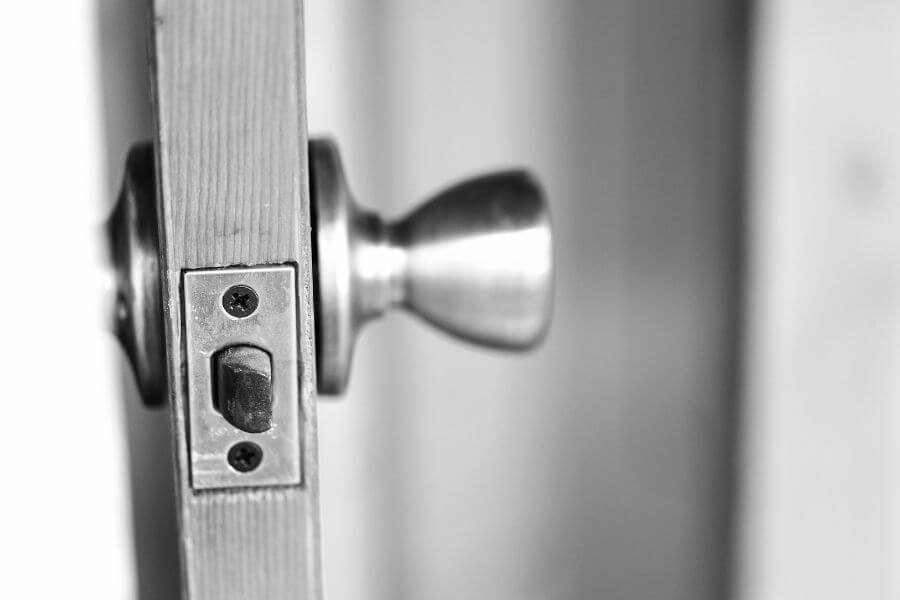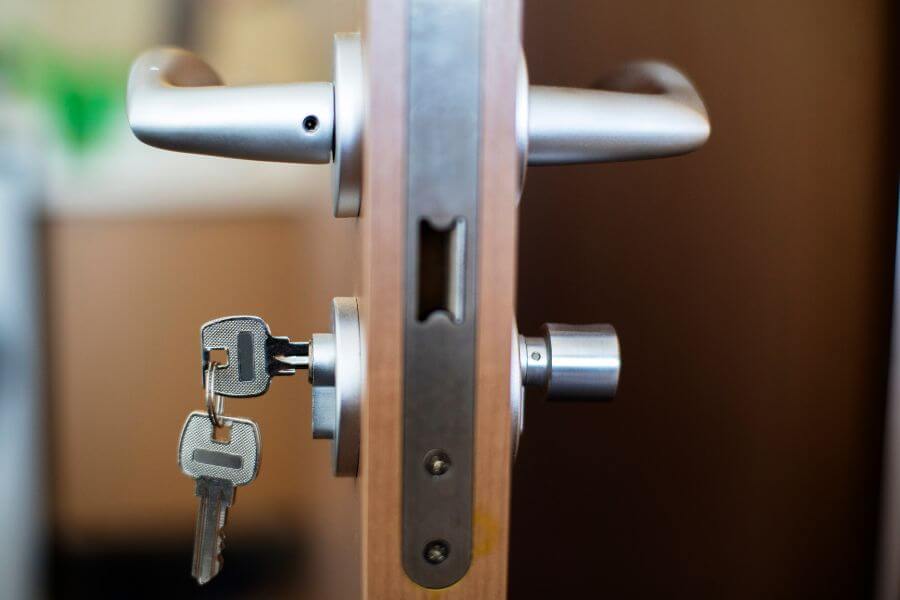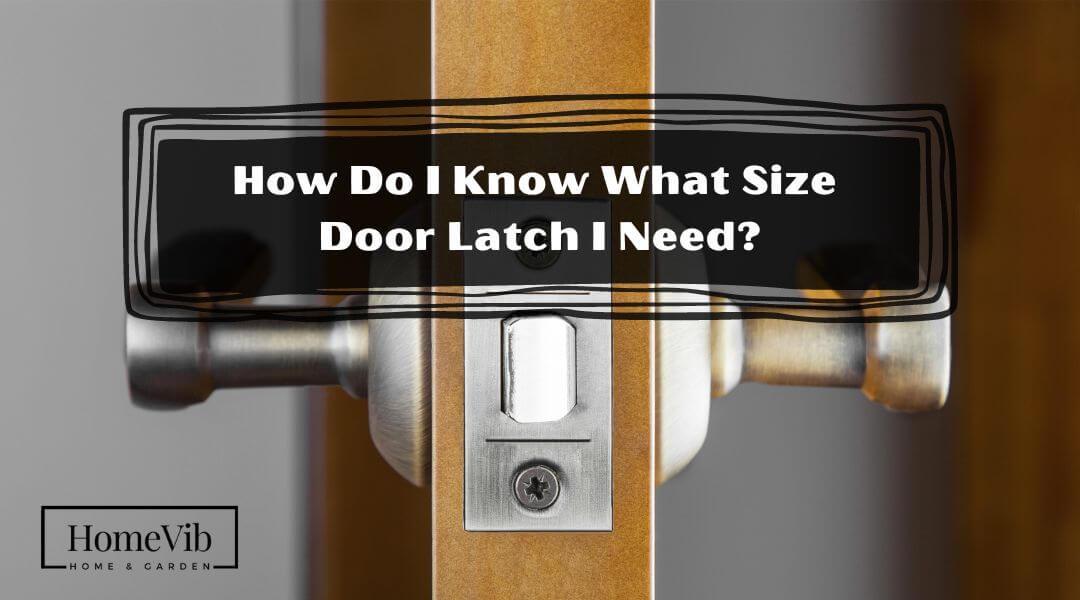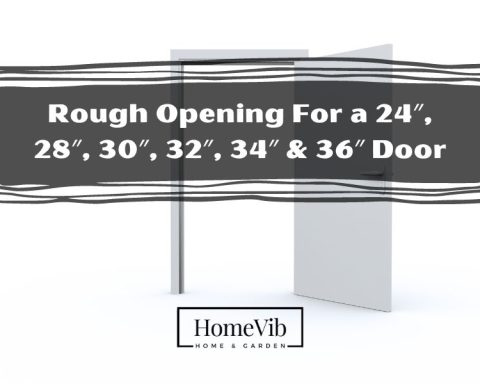When considering internal door locking systems, you’ll encounter something called a door latch. It’s one of the most significant door components, so it’s vital to understand how each gear functions.
Door handles or doorknobs may be used to open a door using a door latch, a door frame system commonly morticed. The guidelines in this post will help you choose the appropriate size for your door latch.
To determine the size of the door latch that you need, you must know the correct size. Door handle latch sizes are usually advertised with their overall length, like the case. After measuring the case size horizontally, measure the backset size.
Let’s look at some recommendations for determining what size of door latch you should use.
Do Door Latches Come in Different Sizes?

When it comes to mortice locks and cylinder locks, specific lock sizes are indeed standard.
In the United States, there are two measurements.
For cylindrical locksets, a 2 1/8′′ hole is the typical size. The most typical shape in residential contexts is cylindrical.
The backset, which measures the distance from the edge of the door to the center of the hole, is often 2 3/8 inches or 2 3/4 inches, with 2 3/8 being more popular. For both purposes, the majority of locksets have an adjustable latch. In addition, 5′′ backsets are also available.
However, in some regions, the measurements of some locks are a little unique and need to fit these standard specifications. Therefore, you must measure the existing lock’s size and get a replacement as close to the original measurements as feasible if you want to replace a lock.
Two main sizes, 2.5′′, and 3′′ are available for mortice deadlocks. For a sash lock, the same is valid. However, these two motifs can be found in different ways and in a massive variety of sizes.
They are typical for the cylinders that power modern multipoint “lift to lock” doors. However, the sizes vary by a 5mm increment on either side. 30/30 or is necessary. 70/30, 45/55. And all without a key, just a thumb turns on either end if necessary.
What Is the Standard Size for a Door Latch?
The standard size for a door latch has a 2 1/2″-deep case, and 1 3/4″ separates the center of the square operating spindles. However, most lever knobs on back plates with a width of 1.55″ to 1.8″ may be less, including a latch this length.
In the U.S., it is also necessary to consider the size of your physical doors. Below are several “regular” sized doors:
- Front Entrance Doors = 36″ x 80″
- Back Doors = 32″ x 80″
- Interior Doors = 32″ x 80″
- Bathroom Doors = 30″ x 80″
Keep in mind: These are the presumptions that contractors and architects would undertake.
Another size of a latch’s casing is 76mm deep and 57mm from the center of the square operating spindle in the following standard size.
Lever handles on backplates of 50–55mm width is often used with door latches of this type. This is the preferred latch for levers on door knobs because roses typically exceed 50mm in diameter.
At the same time, tubular latches come in less recent versions with case depths of 100mm, 125mm, and 150mm. Those are only used for knob sets, and the size selection is based primarily on the desired aesthetic appearance of the door.
Determining the backset of a door with a lock or latch attached:
- If you replace current locks and latches using corresponding replacements, they are still mounted in the door.
- You can calculate the lock’s size by calculating the distance from the door’s edge to the center of the handle or knob.
- You can identify the size lock or latch you use by utilizing the measurement above to get the relative amount of the backseat.
How Do I Know What Size Door Latch I Need?

You must know the correct size to determine the door latch you require. Typically, the dimensions of door handle latches are listed along with their entire length. Next, measure the backset size after measuring the case size horizontally.
The handle will be as central to the stile on your door as appropriate if you choose the nearest backset to this measurement.
Keep in mind the following when determining the size door latch that you need:
- Trim-only Sets
- Important Measurements
- Standard Door Thickness
- Bore Hole
- Backset
Regardless of whether a lever-on-backplate or lever-on-rose is picked, if you were to pick a commonly used device for lever door handles, you might need a 76 mm door latch.
The 76mm latch for rose door handles and the 64mm latch for door handles on a rear plate are the ideal sizes from the perspective of door lock specialists.
Can You Adjust How Far a Door Latch Sticks Out?
Most available door latches are movable, allowing you to modify the backset from 2-3/8″ to 2-3/4″.
To adjust the door latch, here are some steps:
Step 1. Taking off the door knobs
Remove the strike plate first. After that, shut the door and make a note on the jamb where the latch’s center touches the latter. The strike’s focal point will be here.
Hold the strike on the jamb so the mark on the jamb and the strike’s center line up. Then, with a pencil, trace the strike’s perimeter. Trace the hole as well.
Step 2. Pull the latch bolt assembly
Use a screwdriver as a lever to remove the object from the doorknob hole.
Extend the strike mortise to the strike’s outline using a tiny, pointed chisel. Enlarge the latch hole with the chisel.
Remove the strike plate, raise it to the desired height, and draw a pencil border around it. Another hole can be bored with a 3/4′′ drill bit, or you may need to drill numerous small holes and remove the core by chiseling.
You’ll also need to chisel the strike plate’s perimeter to set that flush down.
Step 3. Before being fitted, release the latch bolt and tab
Hold the strike on the jamb so the mark on the jamb and the strike’s center line up. Then, with a pencil, trace the strike’s perimeter. Trace the hole as well.
Extend the strike mortise to the strike’s outline using a tiny, pointed chisel. Enlarge the latch hole with the chisel.
Step 4. Take a screwdriver and pry at the left side’s circular notch
This will push the assembly past the door’s edge.
New screw holes should be drilled somewhat smaller than the screws. You might require extra-long screws that can reach the timber behind the frame if one of your screws falls into the old latch hole.
The frame is permanently damaged when the strike is moved. Even though you can try to fill in the old mortise, it usually looks bad. Rehanging the frame could be simpler than inlaying a filler using sophisticated woodworking.
How To Adjust Door Latch Length?
You must prepare the door before altering the door latch length. The steps are as follows:
1. Installing and adjusting latches. Measure your door and get ready with the following tools:
- Locking Deadbolt
- Leverset Latch
- Handleset Latch
2. Measure door thickness
• If the door is 1-3/4 “, Use shorter lock mounting screws (44 mm).
• If the door’s width extends from 1-3/4″ (44 mm) to 2″ (51 mm):
Use the longer torque blade that is included in the package.
Use the longer mounting screws supplied in the package to install the deadbolt.
3. Install trim
4. Install knob/lever
5. Install strike
After finishing, swap out the current cylinder torque blade for the longer torque blade replacing the handle set spindle mechanism next using the one from the box. Finally, install the internal deadbolt cylinder and the chassis inside trim using longer bolts.
F.A.Q.
What Is the Door Latch Backset?
The backset is the distance between the center of the 2-1/8-inch bore hole and the edge of the door.
There are two typical backsets for residential door locks in the United States: 2 3/8 inches and 2 3/4 inches.
Pack each lock with a 2-3/8-inch or 2-3/4-inch latch, according to which backset you pick. Simulated sets can be installed at any place on the door since they are surface-mounted and without a latch.
In finding the right door latch, there are other things to consider, but if your doors have already been cut for a specific backset, modifying them without compromising the finish on the door face will be challenging.
Ideally, you need door handles with a large enough backplate or rose to disguise the change if you wish to switch your door handles from lever to knob style. In addition, it might be essential to redecorate to conceal any marks left by the edges of the backplate of the existing handle.
How Do You Measure the Door Latch Backset?
To measure for your back set, take your tape measure to the edge of the door and drag it across. For example, a 2 3/4 bottom hole has been drilled. You can either measure at the center of the keyhole or the center of the lock on top.
You used a 2 3/8 drill bit to drill this mount at the top. Then, looking at the center of the hole, you pull your tape measure across. And it weighs two and three-eighths of a pound.
Then leave and open your door. Once more, you’ll take your tape measure to the edge of the door, pull it across, and check to see where it aligns with the center of the lock. Given that we are using a commercial application, you should always check your backset twice. This is 2 3/8. Thus, a two and three would be required for the back set on this door.
Simply put, measure the distance here between the outer edge of the door and the center, or the highest point, of the borehole to calculate the backset on your door. Then measure from the border of the door to the center of the backplate behind the door frame if there is already door equipment in position.









